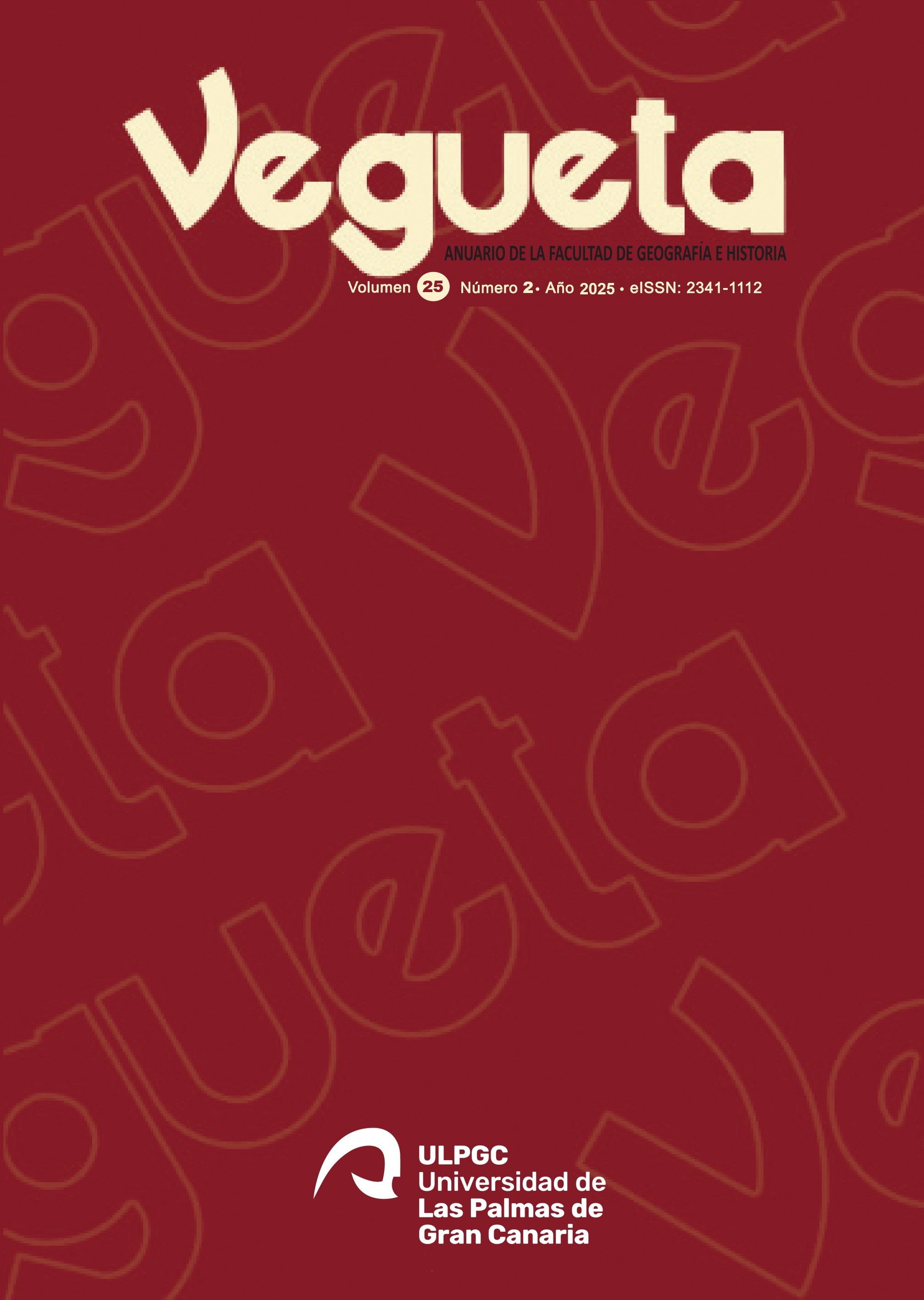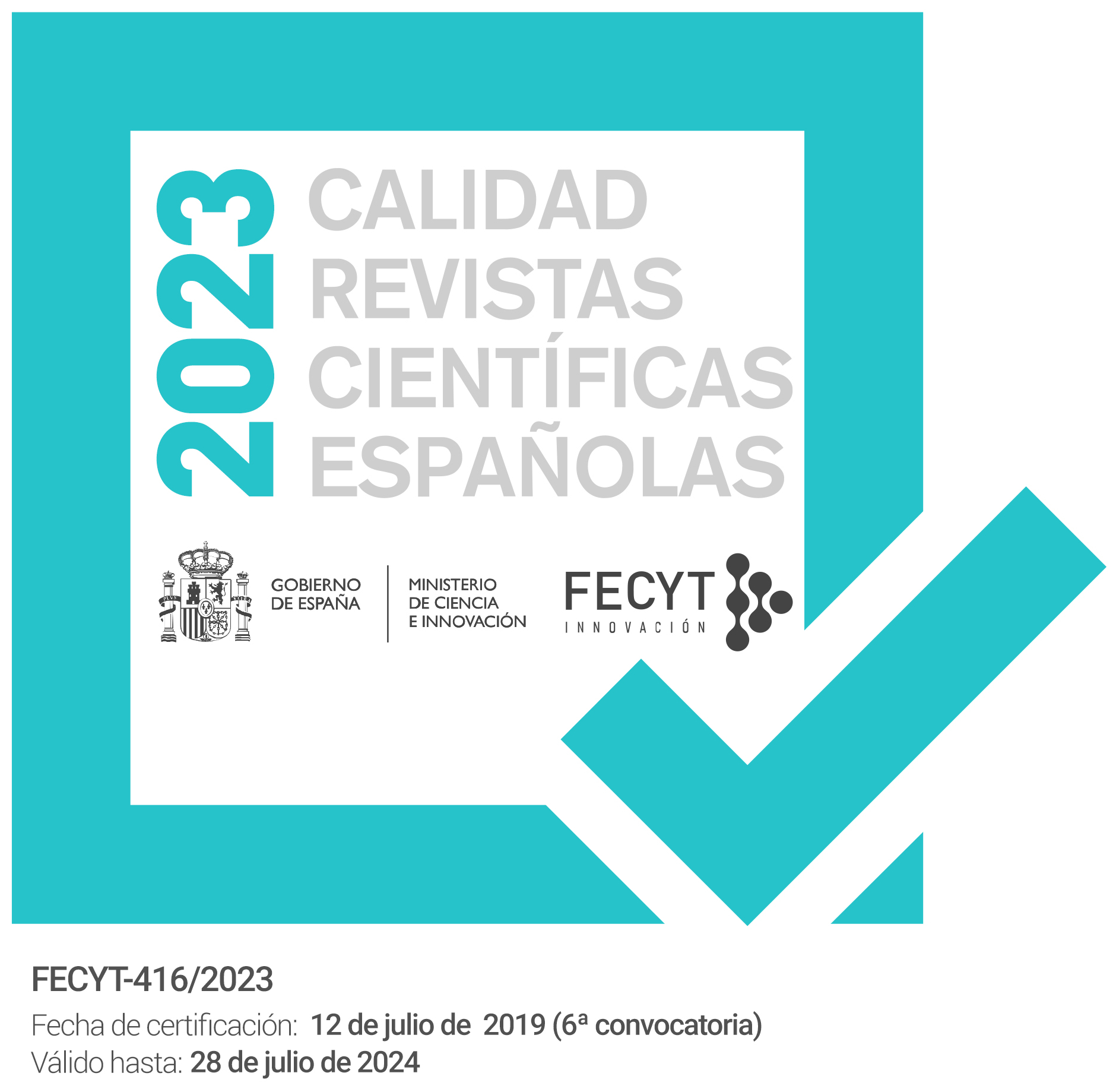A possible late ancient synagogue in Cástulo. Study of Building S of the city
DOI:
https://doi.org/10.51349/veg.2025.2.17Keywords:
synagogue, jewish, church, Castulo, late antiquityAbstract
In the geographical center of the Ibero-Roman city of Cástulo (Area 1), there is an apsidal building, Building S, traditionally defined as a church from the second half of the 4th century AD. However, new excavation campaigns carried out between 2011 and 2021 have documented in this area a notable series of materials that can be related to the establishment of a Jewish community between the 4th and 5th centuries AD. This, together with certain differences in Building S in relation to the characteristics that define Hispanic churches of late antiquity, has led to the analysis of this building with the possibility that it could have been a synagogue. The results obtained are more likely to be linked to Jewish religious buildings than to Christian ones.
Downloads
References
ARTZY, M.; MEIR, E.; COHEN, H. y MISGAV, H. (2023): The Kursi Beach Synagogue and Inscrpition. En LEVINE, L.I; WEISS, Z. y LEIBNER, U. (Eds.). Ancient Synagogue Revealed (1981-2022). Ed. The Institute of Archaeology, The Hebrew University of Jerusalem, 173-180.
BAR-MAGEN NUMHAUSER, A. (2021): Hispanojewish Archaeology: The Jews of Hispania in Late Antiquity and the Early Middle Ages through Their material Remains, nº. 66. Edit. Brill. Leiden (2. Vol.)
BLÁZQUEZ MARTÍNEZ, J.M. y GARCÍA-GELAVERT PÉREZ, M.P. (1999): II. El conjunto arquitectónico del Olivar, British Archaeological Reports S789, Oxford.
BONIFAY, M. (2004): Etudes sur la céramique romaine tardive d’Afrique, British Archaeological Reports S1301, Oxford.
BOTELLA ORTEGA, D. y SÁNCHEZ VELASCO, J. (2008): La Basílica de Coracho. Monografías de patrimonio arqueológico y Etnológico, nº. 2. Edit: Ayuntamiento de Lucena.
BUENACASA PÉREZ, C. (2003): La instrumentalización económica del culto a las reliquias: una importante fuente de ingresos para las iglesias tardoantiguas (ss. IV-VII). En BOSCH, C.; GARCÍA, L.A, y GIL M.E. (Coords.) Santos obispos y reliquias. Edit. Universidad de Alcalá de Henares, 123-140.
CASTELLANOS GARCÍA, S. (2003): ¿Nemo martyrem distrahat? Reliquias de Santos. En BOSCH, C.; GARCÍA, L.A, y GIL M.E. (Coords.) Santos obispos y reliquias. Edit. Universidad de Alcalá de Henares, 141-146.
CASTILLO MALDONADO, P. (1999): Los mártires hispanorromanos y su culto en la Hispania de la antigüedad tardía. Edit. Universidad de Granada.
CASTILLO MALDONADO, P. (2003): El valor representativo, ejemplar y didáctico de mártires y santos en la Antigüedad Tardía. En BOSCH, C.; GARCÍA, L.A, y GIL M.E. (Coords.) Santos obispos y reliquias. Edit. Universidad de Alcalá de Henares, 147-153.
CASTILLO MALDONADO, P. (2006): La época visigótica en Jaén: Siglos VI y VII. Serie Historia Vol. 4. Edit Universidad de Jaén.
CASTILLO MALDONADO, P. (2013): El cristianismo y las iglesias del sur peninsular en la antigüedad tardía: balance Histórico. En Revista Habis, nº. 44. Edit. Universidad de Sevilla, 281-303.
CASTRO LÓPEZ, M.; AYASO MARTÍNEZ, J.R.; ARIAS DE HARO, F.; CEPRIÁN DEL CASTILLO, B. y SOTO CIVANTOS, M. (2013): Cástulo, Sefarad; primera luz. Documento base de proyecto de intervención integral sobre el patrimonio arqueológico. Conjunto Arqueológico de Cástulo, Linares (Jaén, España) (Ined.).
CEPRIÁN DEL CASTILLO, B. (2019): Las Termas del Complejo Arquitectónico del Olivar de Cástulo (Linares, Jaén): un acercamiento histórico y funcional. En Rev. 7 Esquinas, nº. 13. Edit. CEL. Linares, 23-31.
CEPRIÁN DEL CASTILLO, B. (2024): Vajilla de mesa bajo imperial en Cástulo: Terra sigillata hispánica tardía meridional (TSHTM). Edit. Centro de Estudios Linarenses. Linares (e.p.).
CEPRIÁN DEL CASTILLO, B.; CASTRO LÓPEZ, M.; ORFILA PONS, M.; PARRAS GUIJARRO, D.J. y EXPÓSITO MANGAS, D. (2022): Contexto cerámico de vajilla de mesa del nivel de abandono de las termas públicas de Cástulo (Linares, Jaén). en Cuadernos de la SECAH, 5. Edit. La Ergástula S.L., 95-108.
CEPRIÁN DEL CASTILLO, B. y SOTO CIVANTOS, M. (2014): Excavaciones en el área 1: arquitectura y devenir histórico del centro de la ciudad romana. En Cástulo en movimiento: Primer avance del Proyecto Forvm MMX, Rev. 7 Esquinas, nº 6. Edit. CEL. Linares, pp. 73-88.
CEPRIÁN DEL CASTILLO, B.; SOTO CIVANTOS, M. y EXPÓSITO MANGAS, D. (2016): Lucernas con menoráh en Cástulo. en Miscelánea de Estudios Árabes y Hebraicos. Sección Hebreo, 65. Edit. Universidad de Granada, 11-31.
CHAVES TRISTÁN, F. y VELASCO CARRILLO DE ALBORNOZ, F.J.: Catálogo de monedas halladas en la campaña de 1991 de excavación arqueológica del conjunto arquitectónico del Olivar de Cástulo. En BLÁZQUEZ., J.M. y GARCÍA-GELAVERT, M.P. (eds.), El conjunto arquitectónico del Olivar II. British Archaeological Reports S789, Oxford, 172-178.
CONTRERAS DE LA PAZ, R. (1999): Historia biográfica de la antigua ciudad de Cástulo, Edit. Cajasur, Córdoba.
COSTAMAGNA, L. (1991): La sinagoga di Bova Marina nel quadro degli insediamenti tardoantichi della costa Ionica meridionale della Calabria. En Mélanges de l’Ecole française de Rome. Moyen Age, Tome, 193, 611-630.
EXPÓSITO MANGAS, D.; CASTRO LÓPEZ, M.; ARIAS DE HARO, F. PEDROSA LUQUE, J.M. y CEPRIÁN DEL CASTILLO, B. (2017): A large glass dish from Cástulo (Linares - Jaén, Spain) with an enaved representation of Christ in Majesty. En WOLF, S. y PURY-GYSEL, A. (eds.) Annales du 20 congrés de l'Association Internationale pour l'Histoire du Verre. Romont, 209-212.
FANTAR, M. (2009): Sur la découverte d’un espace cultuel juif à Clipea (Tunisie). En Comptes rendus des séances de l’Academie des Inscriptions el Belles-Lettres, 153e année, nº. 3, 1083-1101.
FERNÁNDEZ UBIÑA, J. (2015): El oficio episcopal en época de Constantino. En VILELLA, J. (ed.) Constantino ¿el primer emperador cristiano?. Religión y política en el siglo IV. Edit. Universitat de Barcelona, 257-268.
FINE, S. (2010): Art and Judaism in the Greco-Roman World: Toward a New jewish Archaeology. Cambridge University Press.
FINE, S. (2019): Synagogues in the Greco-Roman World. En FINE, S. (Ed.) Jewish Religious Architecture: From Biblical Israel toModern Judaism. Edit. Brill. Leiden, 96-121.
FUENTES DOMINGUEZ, A: (2000): Las termas en la Antigüedad tardía: reconversión, amortización, desaparición. El caso hispano. En FERNÁNDEZ, C. y GARCÍA, V. (Coord.) Termas romanas en el Occidente del Imperio. Edit Ayuntamiento de Gijón. 135-146.
GARCÍA SALINERO, R. (2000): El antijudaísmo cristiano occidental (siglos IV y V). Edit. Editorial Trotta. Madrid.
GARCÍA SALINERO, R. (2021): Consecuencias socioreligiosas de la destrucción de la sinagoga y de la conversión forzosa de los judíos de Menorca en 418 E.C., en LAHAM COHEN, R. y NOCE, E. (Eds.), Cristianos, judíos y gentiles: reflexiones sobre la construcción de la identidad durante la Antigüedad Tardía, 79-101.
GARCÍA-DILS VEGA DE LA, S.; ORDÓÑEZ AGULLA, S. SÁNCHEZ VELASCO, J.; VÁZQUEZ PAZ, J. FOURNIER PULIDO, J. (2011): La conversión de un Porticvs monumental de Colonia Avgvsta Firma en recinto funerario cristiano. En Revista Habis, nº 42. Edit. Universidad de Sevilla, 263-291.
GODOY FERNÁNDEZ, C. (1995): Arqueología y liturgia. Iglesias hispánicas (siglos IV al VIII). Edit: Publicacions de la Universitat de Barcelona.
GODOY FERNÁNDEZ, C. (1998): Algunos aspectos del culto de los santos durante la Antigüedad tardía en Hispania. En Revista Pyrenae, nº. 29. Edit. Universidad de Barcelona, 161-170.
GODOY FERNÁNDEZ, C. (2023): Santos y mártires: la documentación arqueológica, en CHAVARRÍA, A. (Coord.), Cambio de Era. Córdoba y el Mediterráneo Cristiano. Edit. Ayuntamiento de Córdoba, 55-60.
HACHLILI, R. (1998): Ancient jewish art and archaeology in the diaspora. Edit. Brill. Leiden.
HACHLILI, R. (2001): The Menorah, the Anciente Seven-armed Candelabrum: Origin, Form and Significance. Brill: Leiden, Boston, Köln.
HACHLILI, R. (2014): Ancient Synagogues – Archaeology and Art: New Discoveries and Current Research, Vol. 105. Edit. Brill. Leiden.
JIMÉNEZ SÁNCHEZ, J.A. (2006): En olor de santidad. La actitud del cristianismo hacia la cultura del baño, Rev. Polis, 18. Edit. Universidad de Alcalá de Henares, 151-161.
KRAEMER, R.S. (2020): The Mediterranean Diaspora in Late Antiquity: What Christianity Cost the Jews. Edit. Oxford Universitiy Press.
LAHAM COHEN, R. (2010): Pervivencias judías en la Península Itálica. La sinagoga de Bova Marina en el ocaso de la Antigüedad Tardía, Revista Claroscuro, Año IX, nº. 9, 171-191.
MARTÍNEZ JIMÉNEZ, J.; SASTRE DE DIEGO, I. y TEJERIZO GARCÍA, C. (2018): The Iberian Peninsula between 300 and 850: An Archaeological Perspective, Vol 6. Edit. Amsterdam University Press. Amsterdam.
MARTÍNEZ TEJERA, A.M. (2006): La arquitectura cristiana en Hispania durante la antigüedad tardía (siglos IV-VII). Estado de la cuestión (I). En LÓPEZ, J.; MARTÍNEZ, A.M. y MORÍN, J. (eds.) Galia e Hispania en el contexto de la presencia “germánica” (ss. V-VII): Balance y perspectivas. British Archaeological Reports 1534, Oxford, 109-187.
MILSON, D. (2007): Art and Architecture of the Synagogue in Late Antique Palestine: In the Shadow of the Church., Vol. 65. Edit. Brill. Leiden.
PRADO TOLEDANO, S. (2002): Cerámica romana del Complejo Urbano del Olivar de Cástulo, Linares. Tesis. Universidad Complutense de Madrid. https://eprints.ucm.es/2424/1/T19868.pdf
SALES JORDINA, G. (2011): Edilicia cristiana hispana de la antigüedad tardía: La "Tarraconensis". Tesis digital de la Universitat de Barcelona, http://hdl.handle.net/10803/22699.
SÁNCHEZ VELASCO, J. (2011): Corduba, en REMOLA, J.P y ACERO, J. (eds.) La Gestión de los residuos urbanos en Hispania: Xavier Dupré Raventós (1956-2006) In Memoriam, ANEJOS de AEspA, Vol. LX. Edit. CSIC, 123-143.
SANCHO I PLANAS, M.; SALES CARBONELL, J. y ALEGRÍA TEJEDOR, W. (2019): Santa Cecilia de Els Altamiris (Sant Esteve de la Sarga, Lleida): un monasterio de montaña entre la antigüedad tardía y la temprana edad media, en LÓPEZ, J. (ed.) Tarraco Biennal. Actes 4t Congrés Internacional d’Arqueologia i Món Antic. VII Reunió d'Arqueologia Cristiana Hispànica: el cristianisme en l’Antiguitat Tardana. Noves perspectives, 225-234.
UREÑA CRUZ, D. (2019): Arqueología de la arquitectura en Cástulo. Una nueva aproximación a las termas del Olivar, Rev. DAMA, 4. Edit. Universidad de Alicante, 217-236.
VILELLA MASANA, J. (2016): Los obispos y presbíteros del supuesto concilio de Elvira, en ACERBI, S.; MARCOS, M. y TORRES, J.M. (dirs.) El obispo en la Antigüedad Tardía: Homenaje a Ramón. Edit. Trotta, 335-354.
WEISS, Z. (2023): Bet She’arim: A New Look at the Synagogue Excavated in 1938-1940, en LEVINE, L.I; WEISS, Z. y LEIBNER, U. (Eds.). Ancient Synagogue Revealed (1981-2022). Ed. The Institute of Archaeology, The Hebrew University of Jerusalem, 108-117.
WILSON, M. (2019): The Ancient Synagogue of Asia Minor and Greece, en FINE, S. (Ed.) Jewish Religious Architecture: From Biblical Israel toModern Judaism. Edit. Brill. Leiden, 122-133.
Downloads
Published
Issue
Section
License
Copyright (c) 2025 Bautista Ceprián del Castillo

This work is licensed under a Creative Commons Attribution-NonCommercial-NoDerivatives 4.0 International License.
The articles are open access distributed under the terms of the Creative Commons Attribution-NonCommercial-NoDerivatives (CC BY-NC-ND) Spain 4.0 license. Authors who publish in this journal agree with the following terms:
a) Authors retain the copyright and guarantee the journal the right to be the first publication of the work as well as licensed under a Creative Commons Attribution License that allows others to share the work with a recognition of the authorship of the work and the Initial publication in this magazine.
b) Authors may separately establish additional agreements for the non-exclusive distribution of the version of the work published in the journal (for example, place it in an institutional repository or publish it in a book), with recognition of its initial publication in this magazine.
c) Authors are allowed and encouraged to disseminate their work electronically (for example, in institutional repositories or on their own website) before and during the submission process, as it may result in productive exchanges, as well as a earliest and largest citation of published works (See The Effect of Open Access).




